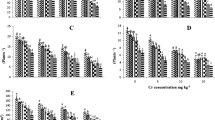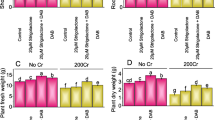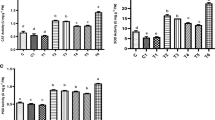Abstract
The present study was conducted to assess the impact of gibberellic acid on growth and yield of sunflower in hexavalent chromium [Cr(VI)]-contaminated soil in the presence as well as absence of pressmud. Seeds of sunflower were sown in potted soil amended with pressmud as an organic amendment and contaminated with different levels of Cr(VI) (12, 18, and 24 mg kg−1) by using K2Cr2O7 salt. Gibberellic acid (10−4 M) was applied at time of seedling emergence in the rhizosphere. The results showed that Cr(VI) stress significantly reduced the growth and yield of sunflower. However, application of gibberellic acid and pressmud reversed the toxic effects of Cr(VI) and improved the growth and yield of sunflower. Combined application of gibberellic acid and pressmud further improved growth and yield compared to their separate application in Cr(VI) stress. Moreover, gibberellic acid and pressmud decreased the uptake of Cr and stabilized it in the soil.

Similar content being viewed by others
References
Ali S, Zeng F, Cai S, Qiu B, Zhang G (2011) The interaction of salinity and chromium in the influence of barley growth and oxidative stress. Plant Soil Environ 57:153–159
Ali T, Mahmood S, Khan MY, Aslam A, Hussain MB, Asghar HN, Akhtar MJ (2013) Phytoremedaition of cadmium contaminated soil by auxin assisted bacterial inoculation. Asian J Agric Biol 1:79–84
Andaleeb F, Zia MA, Ashraf M, Khalid ZM (2008) Effect of chromium on growth attributes in sunflower (Helianthus annuus L). J Environ Sci 20:1475–1480
Anderson AJ, Kent DB, Davis JA (1994) Batch experiments characterizing the reduction of Cr(VI) using sub toxic material from a mildly reducing sand and gravel aquifer. Environ Sci Technol 28:175–185
ATSDR (2000) Toxicological profile for chromium. Agency for toxic substances and disease registry. http://www.atsdr.cdc.gov/toprofiles/tp7.html
Bolan NS, Duraisamy VP (2003) Role of inorganic and organic soil amendments on immobilisation and phytoavailability of heavy metals: a review involving specific case studies. Aust J Soil Res 41:533–556
Bolan NS, Adriano DC, Natesan R (2003) Effects of organic amendments on the reduction and phytoavailability of chromate in mineral soil. J Environ Qual 32:120–128
Boonyapookana B, Upatham ES, Kruatrachue M, Pokethitiyook P, Singhakaew S (2002) Phytoaccumulation and phytotoxicity of cadmium and chromium in duckweed Wolffia globosa. Int J Phytoremediat 4:87–100
Chiu CC, Cheng CJ, Lin TH, Juang KW, Lee DY (2009) The effectiveness of four organic matter amendments for decreasing resin-extractable Cr (VI) in Cr (VI)-contaminated soils. J Hazard Mater 161:1239–1244
Clemente R, Paredes C, Bernal MP (2007) A field experiment investigating the effects of olive husk and cow manure on heavy metal availability in contaminated calcareous soils from Mucia (Spain). Agri Ecosyst Environ 118:319–326
Curaba J, Singh MB, Bhalla PL (2014) miRNAs in the crosstalk between phytohormone signaling pathways. J Exp Bot 65:1425–1438
Eary LE, Rai D (1991) Chromate reduction by subsurface soils under acidic conditions. Soil Sci Soc Am J 55:676–683
El-Shourbagy MN, Ghaffar BA, El-Naggar RA (1990) Effect of IAA and GA3 on growth and mineral element contents of flax (Linum usitatissimum L.). Egypt J Bot 33:269–282
Erdei L, Msller I, Jensen P (1989) The effects of energy supply and growth regulators on K+ uptake into plant roots. Biochem Physiol Pllanz 184:345–361
Farooq H, Asghar HN, Khan MY, Saleem M, Zahir ZA (2015) Auxin mediated growth of rice in cadmium contaminated soil. Turk J Agric For 39. doi:10.3906/tar-1405-54
Farrell M, Perkins WT, Hobbs PJ, Grith GW, Jones DL (2010) Migration of heavy metals in soil as influenced by compost amendments. Environ Pollut 158(1):55–64
Gangwar S, Singh VP (2011) Indole acetic acid differently changes growth and nitrogen metabolism in Pisum sativum L. seedlings under chromium (VI) phytotoxicity: implication of oxidative stress. Sci Hortic 129:321–328
Gangwar S, Singh VP, Garg SK, Prasad SM, Maurya JN (2011a) Kinetin supplementation modifies chromium (VI) induced alterations in growth and ammonium assimilation in pea seedlings. Biol Trace Elem Res 144:1327–1343
Gangwar S, Singh VP, Srivastava PK, Maurya JN (2011b) Modification of chromium (VI) phytotoxicity by exogenous application of Gibberellic acid in Pisum sativum (L) seedlings. Acta Physiol Plant 33:1385–1397
Gheju M, Balcu I, Ciopec M (2009) Analysis of hexavalent chromium uptake by plants in polluted soils. Ovidius Univ Annal Chem 20:127–131
Halter L, Hebbegger R, Schnitzler WH (2005) Gibberellic acid on artichokes (Cynara scolymus L.) cultivated in Germany to promote earliness and to increase productivity. Acta Hortic 681:75–82
Hsu NH, Wang SL, Lin YC, Sheng GD, Lee JF (2009) Reduction of Cr (VI) by crop-residue-derived black carbon. Environ Sci Technol 43:8801–8806
Iqbal M, Ashraf M (2013) Gibberellic acid mediated induction of salt tolerance in wheat plants: growth, ionic partitioning, photosynthesis, yield and hormonal homeostasis. Environ Exp Bot 86:76–85
John R, Ahmad P, Gadgil K, Sharma S (2009) Heavy metal toxicity: effect on plant growth, biochemical parameters and metal accumulation by Brassica juncea L. Int J Plant Prod 3:65–76
Kaszycki P, Gabrys H, Appenroth KJ, Jaglarz A, Sedziwy S, Walczak T, Koloczek H (2005) Exogenously applied sulphate as a tool to investigate transport and reduction of chromate in the duckweed Spirodelapolyrhiza. Plant Cell Environ 28:260–268
Khan S, Ullah SM, Sarwar KS (2001) Interaction of chromium and copper with nutrient elements in rice (Oryza sativa cv BR-11). Bull Inst Trop Agric Kyushu Univ 23:35–39
Khan MY, Asghar HN, Jamshaid MU, Akhtar MJ, Zahir ZA (2013) Effect of microbial inoculation on wheat growth and phyto-stabilization of chromium contaminated soil. Pak J Bot 45:27–34
Kozuh N, Stupar J, Gorenc B (2000) Reduction and oxidation processes of chromium in soils. Environ Sci Technol 34:112–119
Lee TM, Lai HY, Chen ZS (2004) Effect of chemical amendments on the concentration of cadmium and lead in long term contaminated soil. Chemosphere 57:1459–1471
Liu D, Zou J, Wang M, Jiang W (2008) Hexavalent chromium uptake and its effects on mineral uptake, antioxidant defence system and photosynthesis in Amaranthus viridis L. Bioresour Technol 99:262
Mahmood M (2010) Phytoextraction of heavy metals—the process and scope for remediation of contaminated soils. Soil Environ 29:91–109
Maqbool Z, Asghar HN, Shahzad T, Hussain S, Riaz M, Ali S, Arif MS, Maqsood M (2014) Isolating, screening and applying chromium reducing bacteria to promote growth and yield of okra (Hibiscus esculentus L.) in chromium contaminated soils. Ecotoxicol Environ Saf. doi:10.1016/j.ecoenv.2014.07.007i
Noctor G, Foyer CH (1998) Ascorbate and glutathione: keeping active oxygen under control. Annu Rev Plant Physiol Plant Mol Biol 49:249–279
Nriagu JO (1988) Production and uses of chromium. Chromium in natural and human environment. Wiley, New York, pp 81–105
Ozdemir C, Karatas M, Dursun S, Argun ME, Dogan S (2005) Effect of MnSO4 on the chromium removal from the leather industry waste water. Environ Technol 26:397–400
Pandey V, Dixit V, Shyam R (2009) Chromium effect on ROS generation and detoxification in pea (Pisum sativum) leaf chloroplasts. Protoplasma 236:85–95
Park JH, Lamb D, Paneerselvam P, Choppala G, Bolan N, Chung JW (2011) Role of organic amendments on enhanced bioremediation of heavy metal(loid) contaminated soils. J Hazard Mater 185:549–574
Peleg Z, Blumwald E (2011) Hormone balance and abiotic stress tolerance in crop plants. Curr Opin Plant Biol 14:290–295
Rademacher W (1990) New types of plant growth retardants: additional perspectives for practical applications in agriculture and horticulture. In: Pharis RP, And Rood SB (eds) Plant growth substances. Springer, Berlin, pp 611–618
Sabir M, Hanafi MM, Aziz T, Ahmad HR, Rehman ZU, Saifullah M, Murtaza G, Hakeem KR (2013) Comparative effect of activated carbon, pressmud and poultry manure on immobilization and concentration of metals in maize (Zea mays) grown on contaminated soil. Int J Agric Biol 15:559–564
Shanker AK, Cervantes C, Loza-Tavera H, Avudainayagam S (2005) Chromium toxicity in plants. A review. Environ Int 31:739–753
Sharma DC, Forster CF (1993) Removal of hexavalent chromium using sphagnum peat moss. Water Res 27:1201–1208
Singh G, Brar MS, Malhi SS (2007) Decontamination of chromium by farm yard manure application in spinach grown in two texturally different Cr-contaminated soils. J Plant Nutr 30:289–308
Steel RGD, Torrie JH (1984) Principles and procedures of statistics. McGraw-Hill Pub, New York
Stewart BA, Robinson CA, Parker DB (2000) Examples and case studies of beneficial reuse of beef cattle byproducts. In: Dick WA (ed) Land application of agricultural, industrial, and municipal by-products. Soil Science Society of America Inc, Madison, pp 387–407
Terry N, Banuelos G (2000) Phytoremediation of contaminated soil and water. Lewis, New York, p 389
Vernay P, Gauthier-Moussard C, Hitmi A (2007) Interaction of bioaccumulation of heavy metal chromium with water relation, mineral nutrition and photosynthesis in developed leaves of Lolium perenne L. Chemosphere 68:1563–1575
Acknowledgments
Facilities for this study were provided by the Institute of Soil and Environmental Sciences, University of Agriculture, Faisalabad. We are thankful to the Department of Social Sciences and Humanities, Faculty of Sciences, University of Agriculture, Faisalabad, for providing services of editing this manuscript for English language.
Author information
Authors and Affiliations
Corresponding author
Additional information
Responsible editor: Elena Maestri
Rights and permissions
About this article
Cite this article
Saleem, M., Asghar, H.N., Khan, M.Y. et al. Gibberellic acid in combination with pressmud enhances the growth of sunflower and stabilizes chromium(VI)-contaminated soil. Environ Sci Pollut Res 22, 10610–10617 (2015). https://doi.org/10.1007/s11356-015-4275-3
Received:
Accepted:
Published:
Issue Date:
DOI: https://doi.org/10.1007/s11356-015-4275-3




